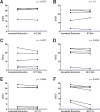Noninvasive Detection of Antibodies to Human T-Cell Lymphotropic Virus Types 1 and 2 by Use of Oral Fluid
- PMID: 31597746
- PMCID: PMC6879298
- DOI: 10.1128/JCM.01179-19
Noninvasive Detection of Antibodies to Human T-Cell Lymphotropic Virus Types 1 and 2 by Use of Oral Fluid
Abstract
Human T-lymphotropic viruses type 1 and 2 (HTLV-1/2) are prevalent in endemic clusters globally, and HTLV-1 infects at least 5 to 10 million individuals. Infection can lead to inflammation in the spinal cord, resulting in HTLV-1-associated myelopathy/tropical spastic paraparesis (HAM/TSP), or adult T cell leukemia/lymphoma (ATL). Obtaining venous blood for serological screening, typically performed using enzyme immunoassays (EIAs), is invasive, sometimes socially unacceptable, and has restricted large-scale seroprevalence studies. Collecting oral fluid (OF) is a noninvasive alternative to venesection. In this study, an IgG antibody capture EIA was developed and validated to detect anti-HTLV-1/2 IgG in OF. OF and plasma specimens were obtained from seropositive HTLV-1/2-infected patients attending the National Centre for Human Retrovirology (n = 131) and from HTLV-1/2-uninfected individuals (n = 64). The assay showed good reproducibility and high diagnostic sensitivity (100%) and specificity (100%) using both OF and plasma. The Murex HTLV I+II commercial assay was evaluated and did not detect anti-HTLV-1/2 IgG in 14% (5/36) of OF specimens from seropositive donors. The reactivities of OF and plasma in the IgG capture correlated strongly (r = 0.9290) and were not significantly affected by delayed extraction when held between 3°C and 45°C for up to 7 days to simulate field testing. The use of OF serological screening for HTLV-1/2 infection could facilitate large-scale seroprevalence studies, enabling active surveillance of infection on a population level.
Keywords: ELISA; HTLV-1; HTLV-2; IgG; diagnostics; gingival crevicular fluid; human T-cell leukemia virus; immunoassays; immunodiagnostics; oral fluid.
Copyright © 2019 American Society for Microbiology.
Figures







Similar articles
-
Seroepidemiology of human T-cell lymphotropic virus type I/II in Benin (West Africa).AIDS Res Hum Retroviruses. 1991 May;7(5):447-51. doi: 10.1089/aid.1991.7.447. AIDS Res Hum Retroviruses. 1991. PMID: 1873079
-
Human T-lymphotropic virus type I (HTLV-I)-specific antibodies and cell-free RNA in crevicular fluid-rich saliva from patients with tropical spastic paraparesis/HTLV-I-associated myelopathy.Viral Immunol. 1995;8(3):141-50. doi: 10.1089/vim.1995.8.141. Viral Immunol. 1995. PMID: 8833267
-
[Investigation of anti-HTLV I/II seroprevalence in healthy blood donors in Izmir region, Turkey].Mikrobiyol Bul. 2010 Oct;44(4):579-84. Mikrobiyol Bul. 2010. PMID: 21063970 Turkish.
-
[Human T-lymphotrophic virus type I and II--diagnosis and clinical presentation].Ugeskr Laeger. 1994 Dec 19;156(51):7663-7. Ugeskr Laeger. 1994. PMID: 7839528 Review. Danish.
-
Serological and Molecular Methods to Study Epidemiological Aspects of Human T-Cell Lymphotropic Virus Type 1 Infection.Methods Mol Biol. 2017;1582:3-24. doi: 10.1007/978-1-4939-6872-5_1. Methods Mol Biol. 2017. PMID: 28357658 Review.
Cited by
-
Saliva-Based ELISAs for Effective SARS-CoV-2 Antibody Monitoring in Vaccinated Individuals.Front Immunol. 2021 Sep 3;12:701411. doi: 10.3389/fimmu.2021.701411. eCollection 2021. Front Immunol. 2021. PMID: 34539632 Free PMC article. Review.
-
Simple, sensitive, specific self-sampling assay secures SARS-CoV-2 antibody signals in sero-prevalence and post-vaccine studies.Sci Rep. 2022 Feb 3;12(1):1885. doi: 10.1038/s41598-022-05640-x. Sci Rep. 2022. PMID: 35115570 Free PMC article.
-
A New Flow Cytometry-Based Single Platform for Universal and Differential Serodiagnosis of HTLV-1/2 Infection.Front Immunol. 2022 Apr 14;13:795815. doi: 10.3389/fimmu.2022.795815. eCollection 2022. Front Immunol. 2022. PMID: 35493505 Free PMC article.
-
Oncoviruses in the Oral Cavity: Recent Advances in Understanding Viral Infections and Tumorigenesis.Int J Mol Sci. 2025 Jul 13;26(14):6721. doi: 10.3390/ijms26146721. Int J Mol Sci. 2025. PMID: 40724971 Free PMC article. Review.
-
Anti-HTLV-1/2 IgG Antibodies in the Breastmilk of Seropositive Mothers.Microorganisms. 2021 Jun 30;9(7):1413. doi: 10.3390/microorganisms9071413. Microorganisms. 2021. PMID: 34209130 Free PMC article.
References
Publication types
MeSH terms
Substances
LinkOut - more resources
Full Text Sources
Research Materials
Miscellaneous

